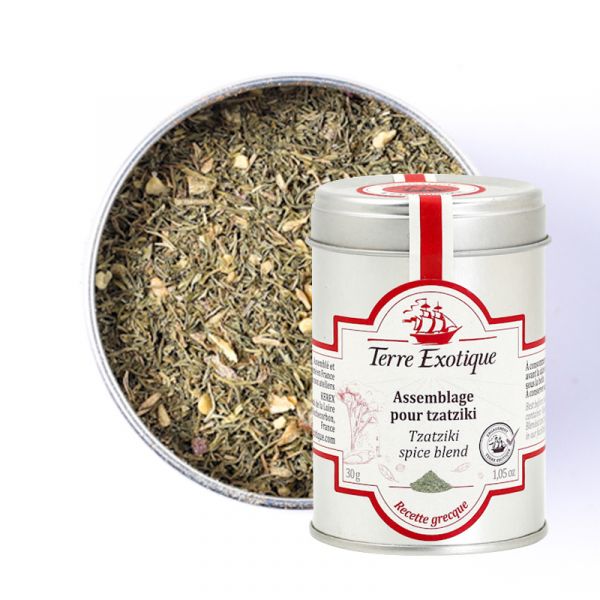



What dishes can you use the tzatziki blend for?
Explore the sweet and fresh flavors of this blend
Of course, this blend will allow you to make your own homemade tzatziki, but it can also be sprinkled on a salad, smoked salmon, or grilled dishes. The simplicity of using the tzatziki blend makes it a crowd-pleaser for appetizers, entrees, or main courses!Our tip? Sprinkle a teaspoon of tzatziki blend into Greek yogurt with a little lemon to accompany raw vegetables for an appetizer.
How to use the tzatziki blend?
Our recipe ideas for using the tzatziki blend in your kitchen:- homemade tzatziki : click here to discover the complete recipe
- sautéed zucchinis: sprinkle your zucchinis with tzatziki blend before frying them;
- Greek-flavored mayonnaise : add a teaspoon of tzatziki blend to your mayonnaise preparation;
- salmon in foil : roll your salmon fillets in the tzatziki blend before cooking them in foil;
- cucumber salad : sprinkle a teaspoon of tzatziki blend on your cucumbers;
- grilled lamb chops: marinate your lamb chops in olive oil with 2 tablespoons of tzatziki blend;
- Greek-style chicken : coat your chicken with Greek yogurt and sprinkle the tzatziki blend on your chicken before baking it in the oven, basting it with lemon juice as you go along;
- celery remoulade : add 1 teaspoon of tzatziki blend to your preparation.
The fresh aromas of the tzatziki blend
Herbaceous, fresh, and garlicky notes emerge from the tzatziki blend to enhance your preparations. As an appetizer or in a main dish, the tzatziki blend will bring all its flavors to your meals.
A Mediterranean blend
The tzatziki blend is composed of dill, garlic, kaffir lime, shallot, and salt. Tzatziki is a Greek and Turkish meze that is served as an appetizer or sauce. A meze is a small dish served to accompany an alcoholic or non-alcoholic drink, in other words, an aperitif. The word tzatziki comes from the Turkish cacik which would be a kind of condiment. Tzatziki is a mixture of yogurt and cucumber. The Turkish tzatziki is more liquid, more like a sauce than a spread like the Greek recipe.
The dill that makes up this mixture, whose botanical name is Anethum graveolens, belongs to the family of Umbelliferae, also called Apiaceae, which includes, for example, coriander, cumin, fennel, and carrot. Umbelliferae are widespread in temperate regions and grow under a Mediterranean climate.
The dill plant can reach up to 70 centimeters high. During the summer season, it blooms in a yellow color, and large umbels similar to small umbrellas form. This aromatic plant grows in the south of France but also in the north, provided it is protected from frost. The dill leaves are harvested during spring and summer. The flowers are most often used to accompany salmon or in cucumber salads in summer and of course in your recipe for the famous Greek tzatziki associated with garlic, combava, shallot, and salt!
Where does tzatziki and its ingredients come from?
The Mezzé from here and elsewhere in the spotlight Tzatziki is a very common Mezzé in Greece, but its origins are in Turkey. It comes from the Turkish preparation called cacik, which is assimilated to a sauce or sometimes a soup that can be found in the kitchens of Southern Europe and the Middle East.This preparation is mainly composed of goat or sheep yogurt accompanied by cucumber, garlic, and dill. In Turkey, tzatziki is more liquid than that of Greece; it resembles more of a cold soup. Closely linked to Greece and Turkey, tzatziki is found in most southern countries. In Iran, it is called Mast ô Khiar, which means "yogurt and cucumber." Further east, in Bulgaria, it is called Tarator and is served as an appetizer in many establishments.
The herb that makes up tzatziki is dill, which comes from ancient Greek "anethon" and means "grows fast." This plant, originally from the eastern Mediterranean, was introduced to Europe by the Romans and finally fell into oblivion. It was during the Middle Ages that this flavorful plant resurfaced in Scandinavian cuisine before joining the cuisines of the world today. Originally, dill was used for its medicinal properties to treat stomach ailments or to ward off bad luck. For the Romans, dill was a symbol of vitality and good health. So many good reasons to prepare a delicious homemade tzatziki!
| Allergen | Sulfites / Sulphites |
|---|---|
| Native country | France |
| Ingredients | dill (EU / non EU), garlic (SULPHITES), combava, shallot, salt. |
| Nutritional Info | VN Energie pour 100 g (energy for 100g) : 1059 KJ / 253 kcal VN Matière grasse (fat) : 4.4 g Dont acide gras saturés (of which saturated fat) : 0.2 g VN Glucides (carbohydrate) : 55.8 g Dont sucres (of which sugars) : 0 g VN Protéines (protein) : 20 g Vn Sel (salt) : 6.9 g |
| TRACES EVENTUELLES D'ALLERGÈNES | céleri, sésame, moutarde, fruits à coques. |
 Français
Français 